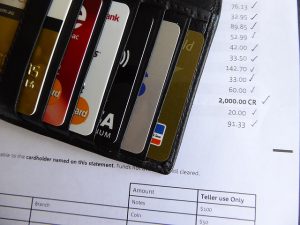A Strategy to Build Wealth, Not Debt
Building wealth is a long-term financial goal that provides financial security, and sets the stage for a comfortable retirement. Although there is no secret formula for becoming wealthy, the process involves developing a solid financial plan, sticking to it, and creating a sustainable strategy that grows your wealth over time.
This typically requires dedication, patience, and discipline and can be achieved by incorporating smart saving and investing strategies, and making wise financial decisions. You probably already heard about budgeting, spending plans, savings strategies, credit cards, and all points in between. Now, we’ll put everything together to make a plan to build lifelong wealth.
Can’t view on YouTube? Click Here
Manage Your Income
Your saving and spending will always depend on how much income you can start with. Your career goals and personal finance goals are the same thing, so always start by looking at your career path.
Making a Career Plan
Interviewers often ask, “Where do you see yourself in 5 years?” You should always have an answer to this question, because it helps build a clear roadmap forward.

Make a career plan by defining your ideal job and salary, and set a series of obtainable goals for the next 5 years. Start by looking at job postings you want to have in the future for your dream job or ideal career. These job postings have all the information you need to make an effective career plan:
- Experience Requirements: use these to define the stepping stones for jobs between now and then.
- Skill/Education Requirements: see what education or training you need to obtain, or skills you need to build, outside your day job.
- Salary offers: usually included in job postings, this will give you an idea of what kind of lifestyle you are building towards. This helps put a cap on the debt you take on today, since it gives a good way to see your ability to pay it off in the future.
Once you do this for your dream job, rinse and repeat for each of the stepping stone jobs you need to meet all the experience and education requirements to get there. Before you know it, you will have a fully-fleshed out career plan with some specific actions you can take today to get there.
Making a Debt Plan
Once you have an idea of how your career can evolve, you know how much space you have for debt. Student loans are often the first type of debt that individuals take on to fulfill the education requirements for their career path. Research the different types of loans, compare the interest rates, and have a repayment strategy in place before choosing which programs or schools you apply to.
You can estimate future pay by looking at job offers for entry-level positions in your desired field. That way you can budget for how long it will take you to pay off your student loans after you graduate and get your first job!
Use Your Spending Plan
Dedicate twenty minutes every month to review your spending by doing a quick account reconciliation to update your spending plan. The key to financial success is knowing where your money is, how it got there, and where it’s going next. No matter how good you are at keeping track of numbers in your head; there is no substitute to reviewing your actual spending habits in your bank account, or in a spreadsheet.
Your Four Accounts
There is a secret way to effortlessly build wealth, while barely paying attention. Split your income automatically, and keep separate accounts for your monthly cash, versus your savings. Most adults with healthy finances use four accounts, but it may be more or less depending on your personal situation.
Account One: Checking Account

A checking account is a type of bank account that allows the account holder to deposit and withdraw funds frequently and provides easy access to your money through various means, such as checks, your debit card, ATMs, and online banking.
Your paycheck is deposited in this account, and this is the account you use for paying all your bills or when out shopping. Setting up automatic payments from your checking account to pay for your monthly bills is a reliable way of ensuring you never miss a payment. With this set-up, the money is withdrawn automatically, which saves time and potential headaches of missed payments, fees, or any damage to your credit score.
Account Two: Savings Account
A savings account is where you can securely store money that you don’t need immediate access to. This account is linked to your checking account. Setting up automatic transfers from your checking account to a regular savings account is an effective way to save money.
With this approach, the money is transferred automatically from your checking account to your savings account every time you receive a paycheck. By setting up automatic transfers, you can reach your saving goals without even thinking about it. This will help with your pay-yourself-first savings strategy, by making sure your wealth is always growing effortlessly.
Account Three: Investing Account
A brokerage account allows individuals to buy and sell securities like stocks, bonds, ETFs, and mutual funds through a brokerage firm using their savings. There are two types of brokerage firms; full-service and online discounted brokerages. Full-service brokers offer comprehensive investment management services, while online discounted brokers offer reduced commission rates and limited investment advice.
A certain percentage of your savings should be invested in the markets; which will have a higher return than what you’ll receive from a normal savings account. No matter how you choose to build your investment portfolio, investing your savings is the most effective way to help it grow.
You can even set-up regular transfers from your savings account to your brokerage account, which will help keep it growing too!
Account Four: Emergency Fund
This is either part of your savings account, or an entirely separate bank account set aside for emergencies. Your emergency fund should have 3 to 6 months of income in it, ready to be withdrawn in case you have a monetary emergency. The purpose of this fund is to make sure that you don’t steal from yourself by withdrawing from your savings.
Every time you need to withdraw from your emergency fund, you will need to fill it back up with your next paycheck. Your goal is to always keep this account topped up in case you need it later. This will mean cutting expenses until you’re back on track.
Account Five: Spending Account (Optional)
If you struggle to control your spending, you may want to have a secondary checking account, specifically set aside with your spending money. Here’s how it works:
- Use your account reconciliation to determine the approximate amount of bills you have each month.
- Set-up your main checking account to transfer funds to your savings account, and to pay all your regular bills automatically.
- Transfer 80% of the money left over to this new spending account (also a checking account).
- Disable overdraft protection on your spending account to ensure you cannot over-draw.
- Use this account when you go out with friends, buy things online, pay for groceries, and any other spending you do throughout the month.

Your spending account is the debit card you keep with you. If you’re using a separate account, leave your normal debit card and credit card locked up at home, so you aren’t tempted to spend beyond what you budgeted.
Separating out your spending account is an effective way of ensuring that all your bills are always paid on time, and your savings continue to grow, even if you have poor spending habits or shop impulsively. When you try to spend more than what you have in your spending account, the transaction will be declined, avoiding any damage to your savings. Although it may lead to momentary embarrassment, the benefits of protecting your savings account override any negative feelings.
Your Credit Card
A credit card is a payment card that is issued by financial institutions allowing the cardholder to borrow money in order to make purchases or pay for services. However, it is crucial to remember that your credit card serves as an extension of your checking or spending account and not as extra money. One of the primary functions of a credit card is to build your credit score. It’s still important to avoid spending more than you can pay off immediately with your checking or spending account to avoid debt and high-interest payments.
Budgeting Guidelines
It’s hard to know exactly how much money to allocate to different expenses. So, use this as a guideline to help you decide how much you spend on each area of your life. These guidelines are based on your net (after-tax) income.
Housing

Generally, personal finance experts suggest that individuals spend no more than 30% of their net income on housing, which includes rent, or mortgage payments. This percentage ensures you have enough income to cover other essential expenses.
In recent years, housing affordability has become a critical issue in many parts of the world. With a severe shortage of affordable housing, many people are struggling to find suitable options. This has led to an increase in the number of people choosing to have multiple roommates or to live with family to help manage costs.
Many cities also face significant supply constraints, as demand continues to outstrip supply, driving up housing costs even further. For most people, housing is the single highest monthly expense, so if you can keep this at an affordable rate, you should be in good standing to meet your savings goals.
Savings
Personal finance experts generally recommend that individuals save at least 10-20% of their income each month, which includes contributions to retirement savings accounts, emergency funds, and general savings accounts. The idea behind this recommendation is to maintain financial stability, set aside funds to meet long-term financial goals, and prepare for unexpected financial events.
Going higher is always better, but saving less than 10% will hurt your long-term financial goals (like saving for a house, or retirement). Of these savings, transfer 80% to your investing or brokerage account, keeping the rest in your savings account.
So far, we’ve allocated up to 40% of our monthly income, just on housing and savings.
Bills and Groceries
Miscellaneous bills and groceries will take up another 30% of your income, this includes items like electricity, gas, water, transportation, your cellphone bill, and internet. Be careful with what you consider part of your groceries, since eating out or picking up snacks from the corner store are not the same thing!
This is another set of spending that will be fixed month-to-month, and should be easy to plan for.
This type of spending also includes all your insurance and car payments. If you are making car payments, this percentage could go up to 35% or 40%, but at this point you are stretching yourself very thin.
Other Spending
After everything else is spent, you should still have at least another 20% of income left for anything else you want. Going out with friends, saving for holiday gift-giving, and buying yourself something nice should all fall into this group.
A rookie mistake for most budgets is forgetting to include this group, but most people cannot go very long without some entertainment spending. Failing to set aside 20% of your income to spend on whatever is a major reason why people end up racking up credit card debt. This 20% chunk should be the spending that you could cut if you are having a rough month and need to replenish your emergency fund.
Challenge Questions
- Why is it important to have a career plan in order to build wealth?
- How can splitting your income into separate accounts, such as checking, savings, investing, and emergency funds, help to build long-term wealth?
- How does regularly reviewing and updating your spending plan help to ensure financial success over time?
- Does earning more money guarantee to build wealth? If so, why? If not, why not?